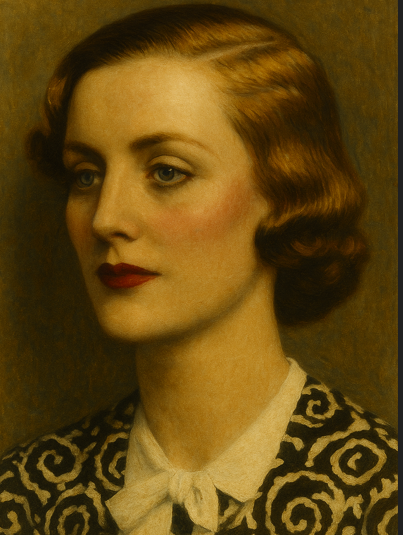
Diana Mitford Mosley: Beauty, Brilliance, and the Shadow of Fascism.
Share
Diana Mitford Mosley was a woman of staggering beauty and staggering controversy. Born on June 17, 1910, she was celebrated in her youth for her beauty, elegance, intelligence, and aristocratic glamour. But as one of Britain’s most notorious fascist sympathizers — and one of the few people who could say they married in the home of Joseph Goebbels with Adolf Hitler as a guest, her life story is also a chilling portrait of charm in the service of ideology.
For those who think of fascism is jackboots and propaganda, Diana is a reminder that it also wore silk dresses and dined in palaces.
Early Life and First Marriage
Diana was the fourth of the seven Mitford children. Born: June 17, 1910, into privilege, eccentricity, and social expectation. Her childhood was spent in country houses, where she learned French, recited poetry, and roamed with her beloved pony. Like her sisters, she was never formally educated, but possessed a sharp, strategic mind and was extremely well-read, devouring classic literature from her father’s extensive library.
At just 18 years old, Diana married Bryan Guinness, heir to the Guinness brewing fortune. Their union was glamorous, gilded, and filled with the trappings of wealth. They had two sons, Jonathan Bryan (b. 1930) and Desmond Walter (b. 1931). But Diana quickly grew bored. The endless social rounds — balls, fox hunts, drawing rooms — left her wanting more out of life.
Below: Diana and her two sons, with Bryan Guinness (c. 1932).

Meeting Mosley — and Changing Everything
In the early 1930s, Diana met Sir Oswald Mosley, a charismatic, ruthless, and married Member of Parliament who had recently founded the British Union of Fascists (BUF). He was almost 14 years older, already a political outcast, and yet Diana was instantly drawn to him. She later wrote that they “became friends rather quickly.” In truth, it was an affair that ignited fast — both romantically and ideologically.
Mosley represented something different: power, purpose, revolution. Diana left her husband in 1933, causing scandal in high society, and began a relationship with Mosley, who still hadn’t divorced his first wife. Even after Mosley's wife, Cynthia, died suddenly in 1933, the couple kept their relationship largely hidden — though Diana's loyalty to him, and to his politics, only deepened.
Marriage in Berlin — With Hitler Present
Diana and Mosley were married in secret in October 1936, in the private home of Joseph Goebbels, Hitler’s Minister of Propaganda. Present at the ceremony was Adolf Hitler himself, who considered Diana a friend and treated her with the familiarity and affection he reserved for few outsiders. For a wedding present, Hitler gave Diana a framed and signed photograph of himself.
It’s hard to overstate how shocking this union was, even decades later. Diana admired Hitler personally and politically and regularly traveled to Germany before the war. She attended the 1935 Nuremberg Rally with her sister Unity, seated among Nazi leadership.
Diana would later claim that Hitler was kind, charming, and a lover of animals. Her sisters were horrified, but Diana — and Unity, who also idolized Hitler — defended him until the bitter end.
The Collapse of the BUF and Wartime Imprisonment
Mosley's political career in Britain collapsed as war loomed. Though he had been a promising MP, his embrace of fascism with its black shirt rallies, anti-Semitic rhetoric, and admiration for Mussolini and Hitler had alienated the public and Parliament alike. By 1939, the British Union of Fascists had lost all real influence, and Diana was publicly despised.
Below: Unity on the left, Diana in the middle and elder sister Nancy on the right, (c.1938)
When war was declared in 1939, the British government regarded Mosley and Diana as national security risks. In May 1940, they were both imprisoned without trial under Defence Regulation 18B — a wartime law that allowed for the internment of suspected subversives. Diana was held at Holloway Prison in London for more than three years, followed by house arrest with Mosley.
While in prison, she was kept in relative comfort compared to others — even allowed to wear her own clothes and receive books. But her incarceration did little to change her views. She maintained her loyalty to Mosley, to fascism, and to Hitler.
Postwar Life in Exile
After their release from prison, Diana and Oswald Mosley were effectively exiled from British life. They moved to Paris where they lived for the rest of their lives in relative comfort but social disgrace. There, they formed a tight friendship with the exiled ex-King Edward VIII and his wife Wallis Simpson, (later the Duke and Duchess of Windsor), who were also living in France.
Though Mosley continued to dabble in fringe politics, including promoting a united Europe under fascist ideas, Diana focused on writing and defending their reputation. In 1977, she published her memoir, *A Life of Contrasts* — part autobiography, part justification. The book caused a stir, especially for its unapologetic tone. Diana made clear that she had never renounced her beliefs, nor did she regret her admiration for Hitler.
Death and Legacy
Diana Mosley died on August 11, 2003, at the age of 93. She had outlived most of her siblings and nearly all of her political allies. Her funeral was private, attended by a small circle of friends and family. She was buried beside Mosley in the village of Orsay, near Paris. Her life remains one of the most polarizing in British history. Was she simply seduced by the glamour of power? Or did she knowingly embrace tyranny with cold, intellectual clarity?
Beauty in the Service of (dis)belief
Diana Mitford Mosley is a case study in how charm and intellect can be used in the service of dangerous ideologies. Her life defies easy categorization: she was brilliant and blind, elegant and extreme. Unlike many who flirted with fascism and later distanced themselves, Diana never looked away — never offered regret or apology.
***
Take a moment to explore our bold, unsettling new portrait of Diana Mitford, inspired by the modern post-war style with an expressionist edge, and part of our exclusive *Mitford Series* collection.
To read more about Diana, or any other member of the Mitford family, be sure to visit our Amazon reading list here.
